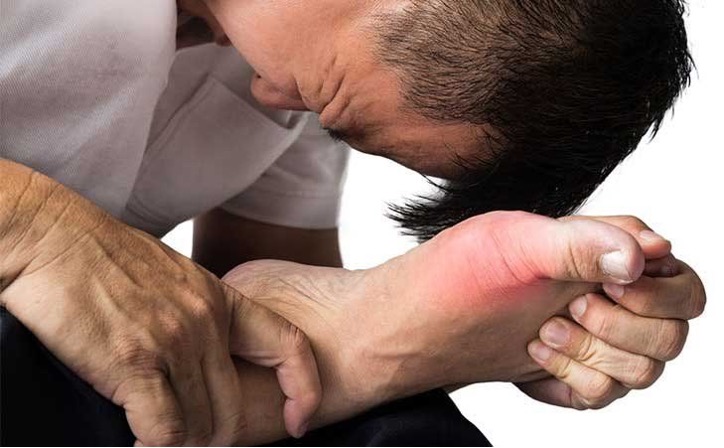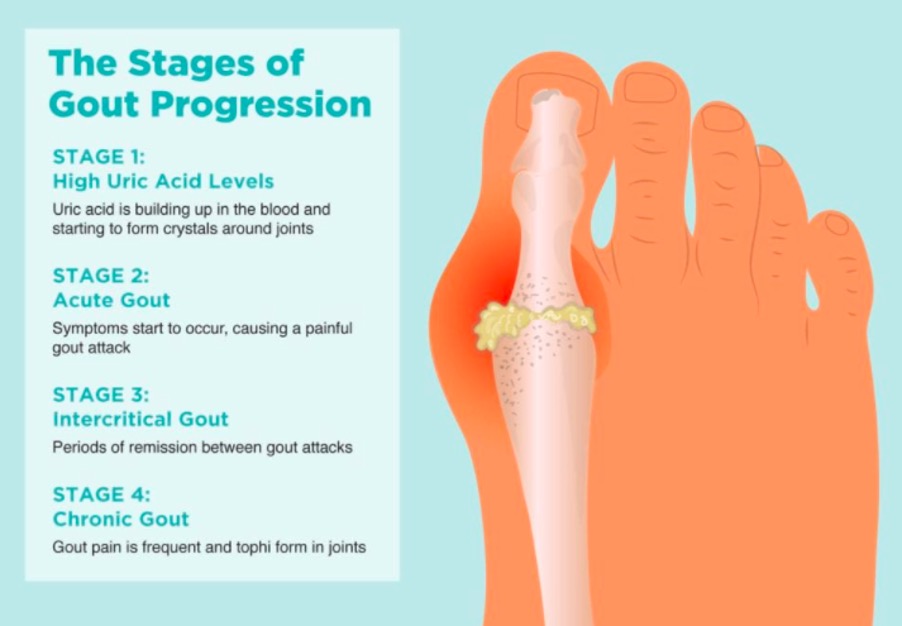
Gout is one of the oldest recorded diseases, with accounts dating back to ancient Egypt. This incredibly painful arthritis affects millions of adults today just as it did in historic times. Though this old disease is becoming more common, but gout can be easily treated and then prevented — with the right care.
Gout is the most common type of inflammatory arthritis that happens when levels of uric acid — a normal byproduct of metabolic reactions in your body (from the breakdown of purines) - become too high. When levels of uric acid get so high that your body can’t easily dissolve and excrete it (via urine), uric acid starts to crystallize. Uric acid crystals deposit themselves in the joints where they cause severe inflammation.
When gout causes severe joint pain, it is called a gout attack, a gout flare-up, or acute gout. Pain is typically accompanied by extreme joint tenderness, swelling, warmth, and skin redness. Gout causes sudden (without warning) and severe joint pain that usually starts in the big toe. Though the big toe is a well-known site of gout attacks, but gout can strike many different joints and areas around the joints. Joints commonly affected include the big toe, the foot’s instep, heel, ankle, and knee. Less often, gout affects the elbow, wrist, fingertips, or spine. These attacks may last a week or two, and another may not occur for months or even years.
Men are three times more likely than women to develop gout. It tends to affect men after age 40 and women after menopause. It is also interesting to know that there are differences between men and women and in which joints are affected:
While women are less likely to get gout, they are more likely to have multiple joints affected by gout.
Gout symptoms can be confused with another type of arthritis called calcium pyrophosphate deposition (CPPD). However, the crystals that irritate the joint in this condition (CPPD) are calcium phosphate crystals, not uric acid.
How a Gout Flare-Up Develops
Gout often develops in some people who have high levels of uric acid from the breakdown of purines, which are found in human cells and many foods, including red meat, organ meats and some seafoods.
Gout results from a build-up of uric acid crystals (monosodium urate crystals) in a joint. These needle-like, microscopic crystals collect in the soft tissue of a joint, causing pain that can be excruciating, as well as swelling, redness, and warmth.
What are Purines?
Purines are important substances necessary for making amino acids, which are the basic building blocks of the human body. Purines are a natural substance found in some foods and is present in all body tissues (and human cells). Our bodies are continually processing purines, breaking them down and recycling or removing the byproducts. When your body digests purine, it produces a waste product called uric acid. A buildup of uric acid crystals in the joints can cause certain health issues.
Purines are found in many foods, aren't all bad, but you want to avoid high amounts. Purines can be found in many foods including (red meat, organ meats and some seafoods), and at different levels. Here are the list of foods that are high in purine content:-
How uric acid crystals form
The build-up of uric acid crystals begins with purines, a chemical compound found in many foods.
Other causes of Gout may result from genes and gender; other health conditions, like high blood pressure, diabetes, obesity or psoriasis; some medications; a high-purine diet. Stress and Injury, an infection or severe illness can also trigger a flare. Starting medicine to lower uric acid may also trigger a flare, so you may need another medication to prevent it.
Why do Gout Flare-Ups Happen at Night
It is not uncommon for gout to flare-up in the middle of the night, waking a person from a sound sleep. In a research study (Nocturnal risk of gout attacks. Arthritis Rheumatol) conducted on more than 700 gout patients, found that flare-ups were 2.4 times more likely between midnight and 8 am than between 8 am and 4 pm. Researchers theorize gout attacks often occur at night because:

Acute Gout vs. Chronic Gout
Acute gout attacks are characterized by a rapid onset and escalation with joint pain typically peaking within 24 hours of attack onset. The pain starts suddenly, often during the night. Other symptoms may include severe pain, often described as throbbing, crushing, or excruciating, the joint appears warm and red, and often very tender and swollen and there may be a fever.
An acute attack often begins to remit after 5 to 12 days without treatment, but complete resolution may take longer in some patients. The pain and swelling most often will go away after the first attack, however many people will have another attack in the next 6 to 12 months.
Others experiencing repeated instances of acute gout ie relapsing problem with multiple severe attacks that occur at short intervals and without complete resolution of inflammation between attacks are called Chronic gout (aka gouty arthritis). This condition can cause significant joint destruction and deformity and may lead to permanent damage of a joint’s tissues and decrease/loss of motion in the joints. May also be confused with other forms of chronic inflammatory arthritis such as rheumatoid arthritis. People with chronic gout will have joint pain and other symptoms most of the time.
People who already have osteoarthritis — the most common form of arthritis ~ often experience their gout attacks in the joints of the finger.
For this reason, it is important to recognize symptoms, understand risk factors, get an accurate diagnosis, and treat and prevent gout.
A combination of one or more of these strategies can help prevent uric acid build-up that leads to a gout attack.
Consuming alcohol inhibits the body’s ability to excrete uric acid, increasing the risk of hyperuricemia and a gout attack. If you can’t avoid alcohol, stick to wine instead.
Instead, increase the intake of foods that are high in antioxidants and anti-inflammatory properties plus Vitamin C-rich vegetables and fruits. Examples of foods to add in your diet are:- dark berries, like blueberries, cherries, legumes, nuts (almonds and walnuts), Omega 3 fatty acids (salmon, mackerel), Tofu/Soy, Pineapple, oranges, grapefruit, broccoli, red peppers. and Coffee.
Increasing water intake will help keep the kidneys healthy and help them flush out uric acid from the body.
Obtaining and maintaining a healthy weight through diet and exercise helps reduce the risk of gout. If you do need to lose weight, make sure your weight loss is gradual as crash diets can increase uric acid levels.
Aim to complete at least 30 minutes of physical activity at least 3 – 4 days in the week.
While more research is needed, some evidence suggests that treating sleep apnea may significantly affect the frequency of gout episodes as increasing oxygen intake may lower uric acid production and thus reduce the risk of a gout attack.
Emotional stress can also bring on a gout attack. So can physical trauma to the foot (such as might occur during running), which may release some crystals and cause an inflammatory reaction.
Learn more how Hi-Bliss Hydrogen Therapy and our Detox Program can help eliminate excess Uric Acid here : https://hi-bliss.com/treatment-services/#treatment. Hydrogen with its antioxidant and anti-inflammatory properties is able to effectively reduce inflammation and flush-out toxins hence minimizing Gout flare-ups.
References:-

Unlock the secrets to radiant skin, optimal kidney function, and a healthy gut.
Discover molecular hydrogen and its incredible health benefits at our exclusive event this December!
📍 Venue: Domitys Bangsar, Kuala Lumpur
📅 Date: 16 Dec 2023 (SAT)
🕙 Time: 10:00am - 1:00pm
🎁 Exciting Announcements & Activities:
FREE Health Check!
FREE Flow of Hydrogen Water!
EXCLUSIVE Promotions!